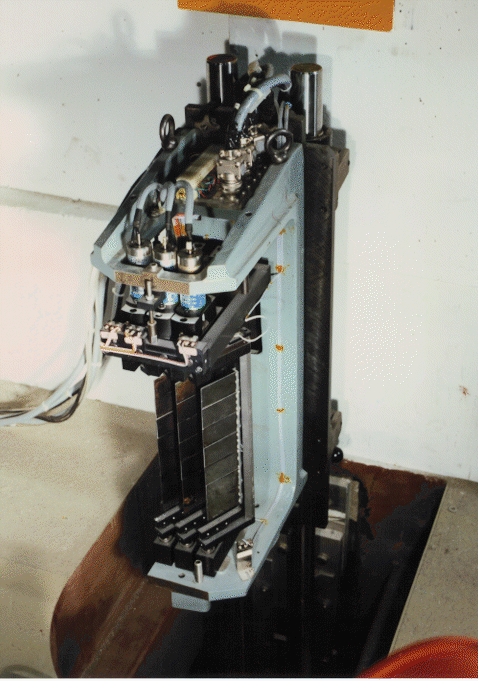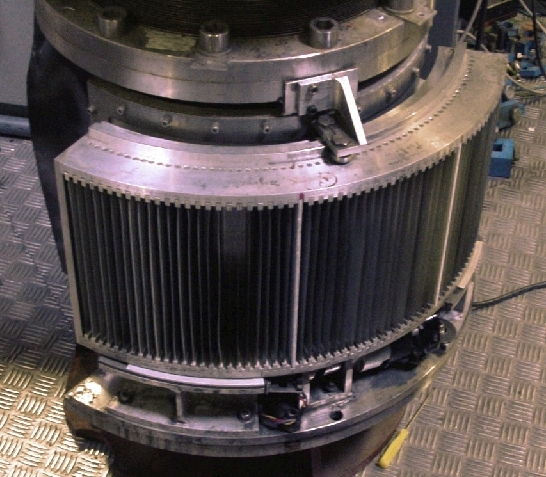SHARP+
CRG - Cold neutron time-focussing time-of-flight spectrometer
Components
Monochromator and Beryllium Filter
The IN6 monochromator bank consists of 3 monochromator arrays with variable take of angles allowing the choice of different incident wavelengths as well as a horizontal focussing of the neutron beam onto the sample. The monochromator arrays are displaced by 30 mm in respect to each other. Each array holds 7 pyrolytic graphite crystals arranged for vertical focussing of the beam. A fixed vertical focus radus of 3000 mm is applied. The crystals are of 29 mm x 54 mm (height x length) size with a mosaicity of about 0.4 degrees.
IN6 is designed to work in a wavelength range of 4.1-5.9 Angstroem. Hence, higher order (shorter wavelength) reflections from the monochromator are filtered out by a beryllium filter located in the reflected neutron beam after the monochromator. This filter is built of two blocks of beryllium with a total thickness of 120 mm. It is kept at liquid nitrogen temperatures for working conditions with an experimentally determined transmission of as high as 90 % at a wavelength of 4.6 Angstroem.
Fermi Chopper and Slit Collimator
The IN6 chopper unit comprises two cylindirical choppers.
A so-called Fermi chopper, located as close as possible to the sample position (39.5 mm), forms the neutron pulses and determines, thus, the energy resolution of the instrument. The neutron pulses are shaped by a rotating slit collimator consisting of a sequence of 200 neutron transmitting aluminum (0.2 mm thick) sheets separated by neutron absorbing gadolinium (0.025 mm thick) foils. A full width at half maximum of 1.4 degrees has been established experimentally for the transmission function of the slit collimator. Depending on the experimenal condition chopper frequencies of 60-250 Hz are applied.
A so-called suppressor chopper is located between the berylium filter and the Fermi chopper. Its function is to clean the monitored sample signal from frame overlap effects, i.e., to suppress the spill-over of signals stemming from subsequent neutron pulses. The extent of spill--over effects is dependent on different conditions. It can be enhanced by the instrumental setup (e.g. high chopper frequencies for high resolution experiments), the physics of the sample (materials with a rich and extensive spread of excitations covering a wide range of energies) as well as by experimental requirements (materials at very high temperatures). The speed of the suppressor chopper is given by f/n with f the Fermi chopper frequency and n = 1, 2, 3, ..., thus, cutting out none of the pulses n = 1 (maximum flux), every second pulse n = 2, every third n = 3, etc.
Practical info
Sample environment
| characteristics | Stick length | Monte-et-baisse position | Sample holder | |
|---|---|---|---|---|
cryostat | 1.5 ... 310 K | 925 | 623 | Ø70 M8 |
cryofurnace | 2.5 ... 600 K | 925 | 580 | Ø70 M8 |
cryoloop N2 | 100 ... 620 K | fixed | 623 | round slab |
cryoloop He (cold finger) | 30 ... 620K | fixed | 625 | M8 |
furnace I | 300 ... 1000 K | 400 | ≥ 625 | Ø69 M8 |
furnace II | 300 ... 1500 K | 400 | 649 (≥ 625) | Ø49 M8 |
Downloads
IN6 Design Study
'Another Time Of Flight Spectrometer IN5bis/IN6' a proposal by R. Scherm, C. Carlile, J. Dianoux, J.-B. Suck, and J. White
IN6 DesignStudy Scherm 1976.pdf (pdf - 1.24 Mi)
IN6 design study by Scherm et al. 1976
IN6 Report
'Le Spectrometre A Temps De Vol IN6, characteristiques, techniques at performances', report 83Bl21G by Y. Blanc
in6 blanc 1983.pdf (pdf - 2.07 Mi)
IN6 performance report by Y. Blanc 1983
Manual : Self-Consistent Multi-Phonon Corrections
'MUPHOCOR, a Fortran Program to Determine the Phonon Density of States from Neutron Scattering Experiments' by W. Reichardt
Reicherdt MuphoCorr.pdf (pdf - 0.90 Mi)
Manual for MuphoCorr by Reichardt

 (gif - 199 Ki)
(gif - 199 Ki)
